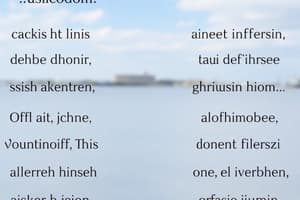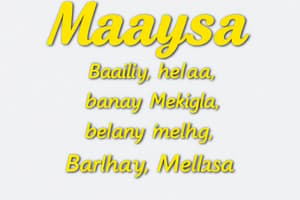Podcast
Questions and Answers
在对话中,大卫的国籍是什么?
在对话中,大卫的国籍是什么?
- 加拿大 (correct)
- 中国
- 日本
- 法国
以下哪个句子使用了“是”字句的否定形式?
以下哪个句子使用了“是”字句的否定形式?
- 我叫大卫。
- 她是老师。
- 我不是学生。 (correct)
- 你是中国人吗?
以下哪种情况使用“吗”来构成疑问句是正确的?
以下哪种情况使用“吗”来构成疑问句是正确的?
- 她也叫安妮。
- 你叫大卫吗? (correct)
- 我叫大卫。
- 他们是教师。
“他是法国人吗?”这句话的正确回答是?
“他是法国人吗?”这句话的正确回答是?
在以下句子中,哪个表示我不是法国人的意思?
在以下句子中,哪个表示我不是法国人的意思?
副词“也”在句子中通常放置在什么位置?
副词“也”在句子中通常放置在什么位置?
当‘不’出现在四声音节前时,应以什么音调发音?
当‘不’出现在四声音节前时,应以什么音调发音?
以下哪种结构不是汉字的基本结构?
以下哪种结构不是汉字的基本结构?
下列哪个偏旁与‘女性’有关?
下列哪个偏旁与‘女性’有关?
‘我也不是学生’中‘也’的功能是什么?
‘我也不是学生’中‘也’的功能是什么?
Flashcards
我是中国人
我是中国人
我 是 中国人 – I am Chinese
你不是中国人吗?
你不是中国人吗?
你 不是 中国人 吗? – Are you not Chinese?
我是老师
我是老师
Wǒ shì lǎoshī – I am a teacher
你是学生吗?
你是学生吗?
Signup and view all the flashcards
我叫大卫
我叫大卫
Signup and view all the flashcards
副词“也” (fùcí “yě”)
副词“也” (fùcí “yě”)
Signup and view all the flashcards
“不”的变调 (bù” de biàn diào)
“不”的变调 (bù” de biàn diào)
Signup and view all the flashcards
汉字基本结构 (hànzì jīběn jiégòu)
汉字基本结构 (hànzì jīběn jiégòu)
Signup and view all the flashcards
偏旁 (piānpáng)
偏旁 (piānpáng)
Signup and view all the flashcards
读写练习 (dúxiě liànxí)
读写练习 (dúxiě liànxí)
Signup and view all the flashcards
Study Notes
Greetings and Introductions
- Basic greetings: Nǐ hǎo (你好) means "hello" or "good day".
- Self-introduction: Wǒ jiào [your name] (我叫[你的名字]) means "My name is [your name]".
- Asking nationality: Nǐ shì [country] rén ma? (你是[国家]人吗?) means "Are you from [country]?"
- Responding "yes": Shì (是) means "yes".
- Responding "no": Bú shì (不是) means "no".
Identifying People and Places
- Identifying people: Tā shì [country] rén (他是[国家]人) means "He is from [country]". Tā jiào [name] (她叫[名字]) means "Her name is [name]"
- Identifying places: Rìběn (日本) means "Japan", Făguó (法国) means "France", Jiānádà (加拿大) means "Canada".
Vocabulary
- Basic words: nǐ (你) - you (singular), wǒ (我) - I, jiào (叫) - to call/name, shì (是) - is/am/are, rén (人) - person, tā (他/她) - he/she, bù (不) - not, hão (好) - good/well/fine.
- Nouns: Riběn (日本) - Japan, Făguó (法国) - France, Jiānádà (加拿大) - Canada
- Other words: ma (吗) - interrogative particle, lǎoshī (老师) - teacher, xuésheng (学生) - student
Sentence Structures
- Subject-verb-object (SVO): Basic sentence structure (e.g., Nǐ hǎo! means "Hello!")
- Interrogative sentence: Add "ma" (吗) to the end of a statement to make it a question (e.g., Nǐ shì Făguó rén ma? "Are you French?")
Studying That Suits You
Use AI to generate personalized quizzes and flashcards to suit your learning preferences.



